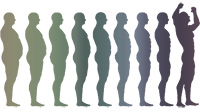
The drawbacks of High Intensity Interval Training (HIIT)
Posted on 19 Mar, 2019

HIIT has been all the rage recently, and the world has been trumpeting its value—from fitness trainers to health magazines to researchers. In practice, however, many health professional are starting to discover drawbacks to this system, particularly when practiced regularly over long periods.
[Related article: The Benefits Of High Intensity Interval Training]
Difficult To Maintain Good Form
 The multi-jointed complex movements and intense pace of HIIT workouts can cause you to stray from proper form, which can result in injury. The goal should be to go as fast as you can, and still maintain proper form and control. Many people focus on speed, not technique.
The multi-jointed complex movements and intense pace of HIIT workouts can cause you to stray from proper form, which can result in injury. The goal should be to go as fast as you can, and still maintain proper form and control. Many people focus on speed, not technique.
It Is Not As Effective At Developing Your Aerobic System
 While beginners may see some improved aerobic functioning with HIIT, they quickly reach a point of diminishing returns. Since the advent of HIIT (anaerobic exercise), many have ditched their traditional cardio workouts (aerobic) entirely, which is a big mistake. Each system places very different demands on your heart, lungs and muscles, and it’s important to develop each area. One could be anaerobically fit but aerobically weak, meaning you could be lightning fast and strong, but gas out quickly.
While beginners may see some improved aerobic functioning with HIIT, they quickly reach a point of diminishing returns. Since the advent of HIIT (anaerobic exercise), many have ditched their traditional cardio workouts (aerobic) entirely, which is a big mistake. Each system places very different demands on your heart, lungs and muscles, and it’s important to develop each area. One could be anaerobically fit but aerobically weak, meaning you could be lightning fast and strong, but gas out quickly.
It Is Not For Everyone
 The HIIT approach to cardio exercise is very physically demanding and can be fatal if you attempt it in poor cardiovascular condition. It is crucial that you improve your overall conditioning with low intensity cardio before delving into HIIT.
The HIIT approach to cardio exercise is very physically demanding and can be fatal if you attempt it in poor cardiovascular condition. It is crucial that you improve your overall conditioning with low intensity cardio before delving into HIIT.
It Is Hard To Sustain For A Long Time
 HIIT is effective, and time-saving. But it is not easy. In fact, it takes a monstrous effort. While some may get excited by the challenge, there will be others who will look upon each session with dread. And because of this, it is easy to get burnt out.
HIIT is effective, and time-saving. But it is not easy. In fact, it takes a monstrous effort. While some may get excited by the challenge, there will be others who will look upon each session with dread. And because of this, it is easy to get burnt out.
It Is Not As Effective As Low Intensity Cardio For Lowering Your Heart Rate
 When you exercise at a high intensity, your heart turns over oxygenated blood so fast that it doesn’t get a chance to fully fill before pumping it out. With lower intensity exercise, however, the left ventricle fills completely before it contracts. Over time, this pushes the heart’s chamber to grow in capacity and pump more blood with each contraction, lowering your heart rate.
When you exercise at a high intensity, your heart turns over oxygenated blood so fast that it doesn’t get a chance to fully fill before pumping it out. With lower intensity exercise, however, the left ventricle fills completely before it contracts. Over time, this pushes the heart’s chamber to grow in capacity and pump more blood with each contraction, lowering your heart rate.
Winds You Up Too Much
 HIIT puts you in a fight or flight state, and this often spills over into your rest time. Many people have problems relaxing after a HIIT workout, and they have trouble shutting down. An overdose of HIIT can also trigger anxiety symptoms like jitteriness, sweaty palms, a racing heart and loss of focus.
HIIT puts you in a fight or flight state, and this often spills over into your rest time. Many people have problems relaxing after a HIIT workout, and they have trouble shutting down. An overdose of HIIT can also trigger anxiety symptoms like jitteriness, sweaty palms, a racing heart and loss of focus.
High Occurrence Of Injury
 HIIT’s high-impact format puts a lot more strain on your system than regular exercise, and muscles are often torn in the process. All the grinding of gears, coupled with improper rest and recovery, can lead to serious, long-term injury.
HIIT’s high-impact format puts a lot more strain on your system than regular exercise, and muscles are often torn in the process. All the grinding of gears, coupled with improper rest and recovery, can lead to serious, long-term injury.
Final Word
 The end results of HIIT can be truly amazing, but it comes with its downsides. The key is to develop a blend of high and low-intensity cardiovascular training that’s tailored to your body and your fitness goals. But don’t make the mistake of trying to do both at the same time. The two systems place different demands on your body, and trying to benefit from both simultaneously may not be the best way. A better approach is to periodize your workouts and train in blocks. By doing it this way, you stave off boredom, reduce your chance of injury and will continue to progress beyond your plateaus time and again.
The end results of HIIT can be truly amazing, but it comes with its downsides. The key is to develop a blend of high and low-intensity cardiovascular training that’s tailored to your body and your fitness goals. But don’t make the mistake of trying to do both at the same time. The two systems place different demands on your body, and trying to benefit from both simultaneously may not be the best way. A better approach is to periodize your workouts and train in blocks. By doing it this way, you stave off boredom, reduce your chance of injury and will continue to progress beyond your plateaus time and again.
[Related article: The Benefits Of High Intensity Interval Training]
Photo Credits
Some Great Books On Cardio

by Alex Hutchinson

by Matt Fitzgerald

by P Selter

by Nicholas Romanov

 Most Surprising Unhealthy Foods
Most Surprising Unhealthy Foods The Secret To Desire
The Secret To Desire The Benefits Of High Intensity Interval Training
The Benefits Of High Intensity Interval Training 10 Tips to Push Past a Weight-Loss Plateau
10 Tips to Push Past a Weight-Loss Plateau










